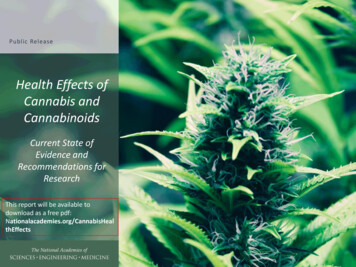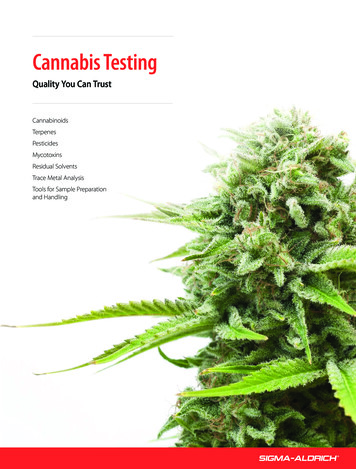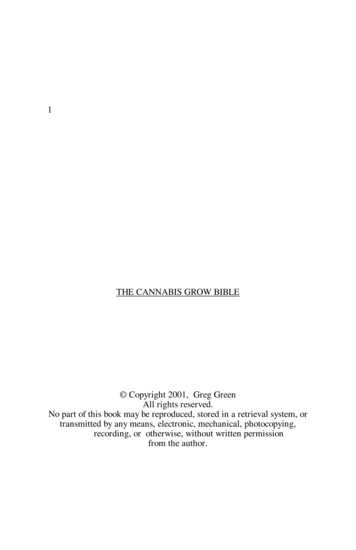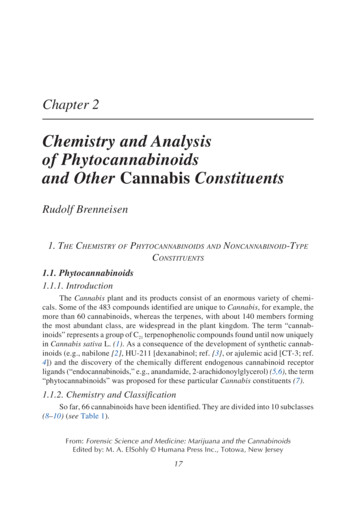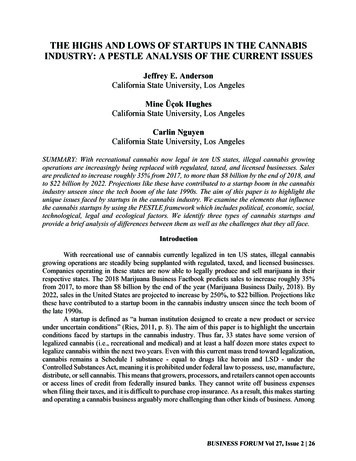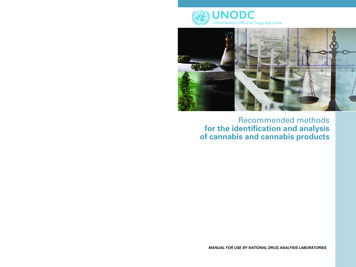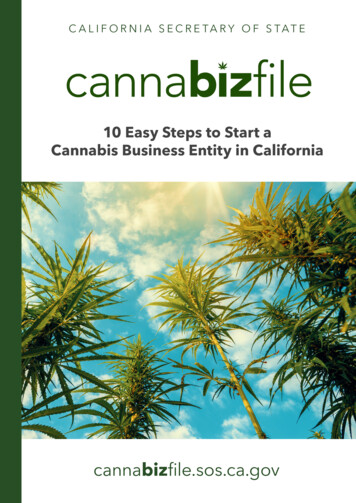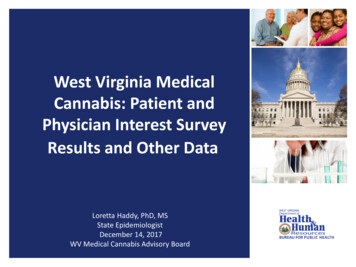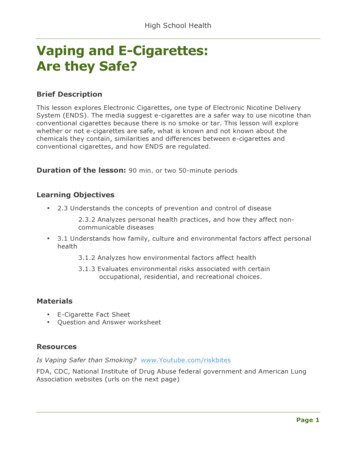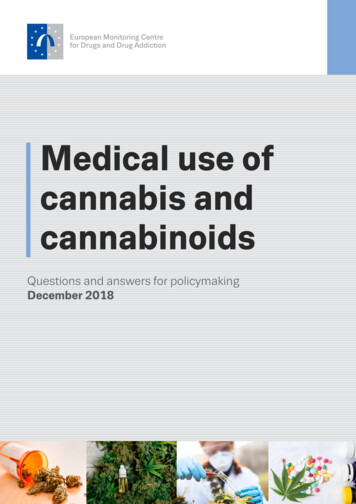
Transcription
Medical use ofcannabis andcannabinoidsQuestions and answers for policymakingDecember 2018
Cannabis, controversies and challenges: introducing a new series of reportsfrom the EMCDDAThe EMCDDA exists to facilitate a more evidence-informed understanding of issuesthat are important for developing better drug-related policies and actions acrossEurope. In a new series of reports, we turn our attention to cannabis, a substancewith a long history of use that has recently emerged as a controversial andchallenging issue in both European and wider international drug policy debates.Cannabis is the most commonly used illicit drug in Europe. It is also the drug aboutwhich both public attitudes and the political debate are most polarised. Interest inthis area is rapidly growing, prompted by some quite dramatic internationaldevelopments in the ways in which some countries and jurisdictions are nowregulating this substance. For Europe, this means that questions on what constitutesan appropriate policy response to cannabis have become both topical and important.In response, the EMCDDA is producing a set of papers that seek to explore, in anobjective and neutral manner, some of the complex issues that exist in this area. Wewill be publishing a series of reports, each addressing a different aspect of thisdynamic and complex policy area. Our aim in this series is to provide an overview ofevidence and current practice for those with an interest in the area, to inform debateand not to advocate for any particular policy perspective.In this report, we examine the evidence for, and practice of, making cannabis orcannabis-based medicines available for therapeutic purposes. This topic is ofgrowing interest, not only because a number of European countries are developingpolicies in this area but also because the international framework may be changingfollowing the recent review of cannabis by the WHO’s Expert Committee on DrugDependence.
Medical use ofcannabis andcannabinoidsQuestions and answers for policymakingDecember 2018
I Legal noticePrinted by the Publications Office in Luxembourg.This publication of the European Monitoring Centre for Drugsand Drug Addiction (EMCDDA) is protected by copyright. The EMCDDA accepts no responsibility or liability forany consequences arising from the use of the data contained in this document. The contents of this publicationdo not necessarily reflect the official opinions of the EMCDDA’s partners, any EU Member State or any agency orinstitution of the European Union.Luxembourg: Publications Office of the European Union, 2018PrintISBN CPDFISBN -N European Monitoring Centre for Drugs and Drug Addiction, 2018Reproduction is authorised provided the source is acknowledged.Photo credits: cover, iStockphotos.comFor any use or reproduction of photos or other material that is not under the European Monitoring Centre forDrugs and Drug Addiction copyright, permission must be sought directly from the copyright holders.Recommended citation:European Monitoring Centre for Drugs and Drug Addiction (2018), Medical use of cannabis and cannabinoids:questions and answers for policymaking, Publications Office of the European Union, Luxembourg.Praça Europa 1, Cais do Sodré, 1249-289 Lisbon, PortugalTel. 351 211210200info@emcdda.europa.eu www.emcdda.europa.eutwitter.com/emcdda facebook.com/emcddaII
IContents5 Introduction6 What topics does this report cover?7 What do we mean by medical use of cannabis and cannabinoids?11 PART 1What evidence is there that cannabis and cannabinoids have medical uses?11 How do we assess the effectiveness of medicinal products?11 What is the current evidence on the effectiveness of cannabis and cannabinoids asmedicines?15 What health risks are associated with the medical use of cannabis andcannabinoids?17 PART 2What regulatory frameworks are relevant to the medical use of cannabis andcannabinoids?17 Is medical use of cannabis and cannabinoids allowed under the international drugcontrol treaties?17 What are the regulatory frameworks within which cannabis or cannabinoids areauthorised for medical use at European level?18 What regulatory frameworks are used to authorise cannabis or cannabinoids formedical use at national level?18 What other regulatory approaches are used to make cannabis or cannabinoidsavailable for medical use without formal marketing authorisation?19 Could cannabis be sold as a herbal medicine?21 PART 3What approaches to allowing the medical use of cannabis and cannabinoidshave countries used?21 How is the medical use of cannabis and cannabinoids regulatedin the United States and Canada?24 What approaches have been used to allow the medical use of cannabis orcannabinoids in the European Union?29 Examples of approaches taken by some other countries to allow the medical use ofcannabis and cannabinoids33 PART 4What are the regulatory challenges in allowing the medical use of cannabis andcannabinoids?35 Glossary37 References44 AcknowledgementsPrepared by Wayne HallUniversity of Queensland Centre for Youth Substance Abuse Research and NationalAddiction Centre, King’s College LondonEMCDDA project group: Liesbeth Vandam, Brendan Hughes, Nicola Singleton,Jane Mounteney, Paul Griffiths
l IntroductionThe medical use of preparations derived from the Cannabis sativa plant has a long history.However, by the twentieth century, medical use of cannabis had largely declined, and itsconsumption for medical purposes was already very limited when in 1961 cannabis wasincluded in the United Nations Single Convention on Narcotic Drugs and classified asa drug that had no medical uses (see ‘A brief history of the medical use of cannabis andcannabinoids’, on page 7). In the past 20 years, however, there has been a resurgence ofpatient interest in using cannabis and cannabinoids to treat a variety of conditions,including chronic pain, cancer pain, depression, anxiety disorders, sleep disturbances andneurological disorders, the symptoms of which are reportedly improved by using cannabis(NASEM, 2017).Increased patient interest in the medical use of cannabis has been accompanied byrenewed scientific interest in the medical use of substances found in the cannabis plant,namely cannabinoids. This followed the discovery, in the early 1990s, of a cannabinoidsystem in the human brain and body that was implicated in the control of importantbiological functions, such as cognition, memory, pain, sleep and immune functioning.However, the classification of cannabis as a drug without medical uses made it difficult toconduct clinical research (NASEM, 2017).In the mid-1990s, citizens in several US states responded to patient demand for cannabisby passing referenda that legalised the medical use of cannabis for people with a variety ofillnesses, such as chronic pain, terminal cancer and multiple sclerosis. A similar approachwas later adopted in many other US states. In 1999, Canada introduced a medicalcannabis programme that expanded over the subsequent decades in response to courtdecisions. In the early 2000s, Israel (2001) and the Netherlands (2003), and later othercountries, such as Switzerland (2011), Czechia (2013), Australia (2016) and Germany(2017), legislated to allow the medical use of cannabis under specified conditions. Overa similar period, clinical trials have provided the basis for granting an authorisation formarketing in many EU Member States of a medicinal product, primarily based on cannabisextracts, that has proven effective in the treatment of muscle spasticity due to multiplesclerosis.Most EU countries now allow, or are considering allowing, the medical use of cannabis orcannabinoids in some form. However, the approaches taken vary widely in terms of boththe products allowed and the regulatory frameworks governing their provision. In thiscontext, this report aims to provide a brief overview of current knowledge and the latestdevelopments relating to medical use of cannabis and cannabinoids.The report is intended to help a broad audience of interested readers, such aspolicymakers, practitioners, potential patients and the public, to understand the scientific,clinical and regulatory issues that arise when consideration is given to making cannabis orcannabinoids available to treat the symptoms of medical illnesses.5
Medical use of cannabis and cannabinoidsImportant caveats when interpreting this report’s findingsThis report has been prepared to respond to growing policy interest in the issue ofthe use of cannabis and cannabinoids for medical purposes. Providing a short andclear overview of such a complex topic area is, however, challenging. Importantly,there are a number of caveats that need to be borne in mind when interpreting thefindings of this report.The area of medical use of cannabis and cannabinoids is extremely dynamic. TheEMCDDA has endeavoured to ensure that this report is as accurate as possible at thetime of writing. However, both the evidence base in this area and policies andpractice are evolving rapidly.There are a number of challenges involved in interpreting the available evidence onthe effectiveness of cannabis medications. The review here is based on the evidenceavailable at the time of writing. Until recently, medical interest in this topic waslimited, a problem complicated by the large number of conditions for whichcannabinoids are purported to be useful. This means that large, well-conductedstudies are scarce. In addition, the knowledge base is constantly changing as newstudies are conducted.Reporting on developments in this area is also hampered by the lack of a common oragreed conceptual framework for describing the medical use of cannabis andcannabinoids. In this report, a simple typology is provided to help address this andaid the interpretation of the data. However, it is not always possible to apply this tothe information sources on which the report is based.National regulatory frameworks are also complicated and there may sometimes bea lack of clarity regarding both the details of the various approaches and how theyoperate in practice. In addition, they evolve over time, and experts sometimesdisagree on how such frameworks should be interpreted legally.lWhat topics does this report cover?Part 1 of the report summarises the evidence on the medicinal properties of cannabis andcannabinoids from systematic reviews of randomised controlled clinical trials. It describesthe strength of the evidence of medical benefits in various medical conditions, discussesthe role that cannabinoid-containing medicines may play in treating these illnesses, andoutlines what we know about the possible harms of short- and long-term medical use.A background paper accompanying this briefing provides more detail on the findings ofrecent systematic reviews of evidence from controlled trials on the effectiveness andsafety of cannabis and cannabinoids (Hall, 2018).Part 2 outlines the legal and regulatory frameworks that are relevant to allowing cannabisand cannabinoids to be used for medical purposes. This section describes therequirements placed on governments by the international drug control treaties. It alsodescribes the type of evidence that pharmaceutical regulators usually require beforeapproving medicines for clinical use in high-income countries. Finally, it considers whethercannabis could be regulated for medical use under special access schemes or as a herbalmedicine.Part 3 gives examples of the various ways in which selected countries have allowed themedical use of cannabis and cannabinoids.6
IQuestions and answers for policymaking December 2018A brief history of the medical use of cannabis and cannabinoids In the 19th century, cannabis tinctures were used in Britain and the US to relievepain and nausea (Grinspoon and Bakalar, 1993; Mechoulam, 1986; Nahas, 1984).The medical use of cannabis declined as drugs were developed in the early 20thcentury that could be given in standardised doses orally or by injection instead ofcannabis extracts that varied in quality and content (Kalant, 2001; Pisanti andBifulco, 2017).The inclusion of cannabis in the Single Convention on Narcotic Drugs in 1961 asa drug with no medical uses ended its medical use in the countries that signed thetreaty (Grinspoon and Bakalar, 1993).A revival of interest in the medical uses of cannabis in the 1970s coincided withwidespread recreational cannabis use among young people in the US (Institute ofMedicine, 1999).Governments feared sending the ‘wrong message’ to young people by allowingmedical use, and the legal classification of cannabis made it difficult to investigateits medical uses in the US (Institute of Medicine, 1999).Interest in potential medical uses was revived in the 1990s following the discoveryof a cannabinoid system in the brain (Iversen, 2003; Pertwee, 1997), whichsuggested that cannabinoids could be used to treat chronic pain and neurologicaldisorders such as multiple sclerosis and epilepsy (NASEM, 2017).Part 4 summarises the regulatory issues that governments need to address when decidingto allow patients to use cannabis or cannabinoids for medical purposes. This includesmaking decisions about the types of cannabis products that patients are allowed to use,the medical conditions for which such products can be used, and the type of medical andregulatory supervision under which patients are allowed to use them.lWhat do we mean by medical use of cannabis and cannabinoids?The ‘medical use of cannabis and cannabinoids’ can refer to a wide variety of preparationsand products (see Figure 1) that may contain different active ingredients and use differentroutes of administration. Although in practice some of the terms in this area have oftenbeen used rather loosely, the distinctions between them have both regulatory and medicalimplications, so it is important to define how we use them in this report.7
Medical use of cannabis and cannabinoidsFIGURE 1Cannabis and cannabinoids used for medical purposes — a broad typologyExamples of medicinal products and their active ingredientsMedicinal productswith marketing authorisationCannabis preparationsCesamet andCanemesMarinol idiolSynthetic cannabinoidsimilar to THCSynthetic THCPlant-based; approx.equal quantitiesCBD/THCPlant-based CBDRaw cannabisMagistral preparationsStandardisedcannabis preparationsVariable in THC/CBD compositionOne important distinction between different forms of cannabis preparations andcannabinoids for medical use is between those that have a marketing authorisation formedical use and those that do not. Having a marketing authorisation means that anapplication for a medicinal product was submitted to a regulatory authority and, afterevaluating the application, the regulatory authority granted authorisation. This usuallyimplies that the product went through extensive clinical trials and that the drug has beentested for safety, effectiveness and side effects. Regulatory authorities also considerwhether the product can be manufactured to a required level of quality.In this report, we use ‘medicinal product’ to refer to the (plant-derived and synthetic)cannabinoid-containing products with a marketing authorisation. Outside the EuropeanUnion, other terms, such as ‘product licence’, ‘drug approval’ or ‘registration certificate’,may be used to refer to a ‘marketing authorisation’.The general term ‘cannabis preparations’ is used in this publication to refer to itemsderived from the Cannabis sativa plant that do not have a marketing authorisation formedical use. These may include the raw cannabis, such as the flowering tops, compressedresin or hash; oils extracted from the plant; concentrated cannabis extracts; and othercannabis preparations, such as soft gels, tinctures or edibles.The raw cannabis may be transformed by a pharmacist into a magistral preparation forconsumption in accordance with a specified medical prescription for an individual patient,or the raw cannabis may already have been transformed by the manufacturer (e.g. intocapsules) in larger batches (standardised cannabis preparations). Examples ofstandardised cannabis preparations include preparations of cannabis flowers, such asBedrocan; granulates, such as Bediol; and oil extracts, such as Tilray 10:10 Balance.Cannabis preparations can vary greatly in composition, depending, for example, on thestrain of cannabis, the growing conditions and how the preparations are stored. Thismeans that they can be difficult to test for efficacy in clinical trials. In this report, the term‘medical use of cannabis’ denotes the use of cannabis preparations for medical purposesby smoking, vaporising or oral ingestion (see ‘Medical use of cannabis preparations— modes of consumption’, page 10).Cannabinoids are substances found in the cannabis plant that act on specific receptors inthe human brain and body (NASEM, 2017); they are the main active ingredients in both themedicinal products derived from cannabis and cannabis preparations. The two most8
IQuestions and answers for policymaking December 2018extensively studied are tetrahydrocannabinol (THC) and cannabidiol (CBD), but some of theother 102 cannabinoids and terpenoids in cannabis may also have medical uses (Russoand Marcu, 2017). Cannabinoids are also found in the human body (endocannabinoids), butthose consumed for medical use may originate from the cannabis plant (plant-derivedcannabinoids, also known as phytocannabinoids) or be synthesised in the laboratory(synthetic cannabinoids). Synthetic cannabinoids may bind to cannabinoid receptors and/or produce similar effects to cannabinoids (Institute of Medicine, 1999; Iversen, 2007).Their chemical structure may not resemble that of any naturally occurring cannabinoids.THC is the cannabinoid that produces the psychoactive effects sought by recreationalusers, such as euphoria, relaxation and heightened sensory experiences (NASEM, 2017).There is also evidence to support the medical use of THC in controlling nausea andvomiting, stimulating appetite and reducing pain (see below). CBD may moderate thepsychoactive effects of THC, and it has medicinal properties, such as reducing epilepticseizures (NASEM, 2017).Several cannabinoid-containing medicinal products have been authorised for marketing;the following are those most commonly referred to: Marinol and Syndros (active ingredient — dronabinol) (1): oral capsules or an oralsolution containing synthetic THC. Dronabinol is indicated for (1) anorexia associatedwith weight loss in patients with acquired immune deficiency syndrome (AIDS) and (2)nausea and vomiting associated with cancer chemotherapy, usually after previoustreatments have failed.Cesamet and Canemes (active ingredient — nabilone): oral capsules containinga synthetic cannabinoid similar to THC. The main indication for their use is nausea andvomiting associated with chemotherapy, usually after previous treatments have failed(Abuhasira et al., 2018).Sativex (active ingredient — nabiximols): a medicinal product containing approximatelyequal quantities of THC and CBD from two cannabis extracts. This product, which issprayed inside the cheek or under the tongue, has been authorised for the treatment ofmuscle spasticity resulting from multiple sclerosis (Iversen, 2007; Russo and Guy,2006).Epidiolex (active ingredient — CBD): a plant-derived CBD oral solution indicated for thetreatment of seizures associated with Lennox-Gastaut syndrome or Dravet syndrome inpatients 2 years of age or older.In this publication, we focus on cannabis preparations and products of which medical useis allowed in at least one country.In the past few years, cannabis-based items (e.g. herbs, hemp and oils) have been offeredfor open sale in shops in several EU countries, based on the claim that they have little or nopsychoactive effect because they contain very low levels of THC and therefore are notcontrolled under national drug laws. They are sometimes referred to as ‘cannabis light’products. Many of these, sometimes claiming to be high in CBD, are purported to be goodfor ‘health and well-being’. These fall outside the scope of the current publication, as theyare not made available under any regulatory framework for medical use (see ‘Low-THCproducts and cannabis products associated with health and well-being’, page 20).(1) Marinol and Syndros both contain synthetic delta-9-THC (dronabinol). However, ‘dronabinol’ may sometimes referto plant-derived THC.9
Medical use of cannabis and cannabinoidsMedical use of cannabis preparations — modes of consumptionAn important issue in the provision of cannabis preparations for medical use is howthey will be consumed.The fastest route to intoxication, and the traditional mode of consumption forrecreational users, is to roll the herbal cannabis or cannabis resin into a cigarette(often mixed with tobacco) and smoke it. As the smoke is absorbed through the lungsinto the bloodstream, the effects of THC on the brain are felt in less than a minute.The harms associated with smoking tobacco are well known. Although it appearsfrom the limited evidence available that smoking cannabis may be somewhat lessharmful, it may still damage the lungs. Accurate dosage is also difficult whencannabis is smoked. Safer and more precise methods of administration are available,such as vaporising below the point of combustion, infusing in hot water (‘tea’) orplacing drops of oil in the mouth. Cannabis edibles, such as chocolates and bakedgoods, have become an important method of administration in the US. Digestingcannabis from edibles, infusion or capsules results in delayed effects — the effectsof THC are felt only after 30-60 minutes — but more accurate pharmaceutical dosingis possible.In the European Union, no country that permits medical use of cannabis preparationsrecommends smoking as a mode of consumption.10
Part 1What evidence is there that cannabisand cannabinoids have medical uses?lHow do we assess the effectiveness ofmedicinal products?In most high-income countries, regulatory authorities granta marketing authorisation after an extensive evaluation ofa submitted application for a new medicinal product.Having a marketing authorisation usually implies that theproduct went through extensive clinical trials (2) and thatthe drug has been tested for safety, effectiveness and sideeffects (Osakwe, 2016; Rago and Santoso, 2008).In controlled clinical studies, patients are randomlyassigned to receive the drug, a placebo, no treatment oranother active treatment for their condition. These trialsgenerally need to show that the drug is more effective thanplacebo, or another currently used medicine, in relievingthe symptoms of the condition (Osakwe, 2016; Rago andSantoso, 2008). There also needs to be evidence that anyharms that the medicine causes are outweighed by thebenefits of taking it. On the basis of all the evidence, theregulatory authority may grant a marketing authorisationfor the medicinal product. The need to take account ofboth efficacy and potential harms means that in somecases authorisation is given when the new medicine is aseffective as or slightly less effective than currently usedmedicines but has a better safety profile.clinical conditions in which the drug may becontraindicated, and interactions with other commonlyused medicines. Clinical guidelines also usually containadvice on where a new medicine fits within establishedforms of treatment for a condition (e.g. as a first-linetreatment or as an adjunctive treatment).In many countries, and in the European Union, aftera medicinal product receives a marketing authorisation,the health authorities are obliged to monitor adverseevents among patients who use it. This post-marketsurveillance aims to detect rare and serious adverseevents that may not have been detected during the clinicaltrials that led to the authorisation. Clinical trials are usuallyshort term and are often conducted in highly selectedgroups of patients. Rarer adverse events may come to lightonly when a drug has been used to treat a large number ofunselected patients (Osakwe, 2016; Rago and Santoso,2008).lWhat is the current evidence on theeffectiveness of cannabis andcannabinoids as medicines?Following authorisation, for some medicinal products,clinical guidelines may be drafted to supplement theproduct information provided by the manufacturer. In thiscase, an organisation such as the National Institute forHealth and Care Excellence in the United Kingdom, andspecialist national and international medical colleges andsocieties, convene expert groups of clinicians to developsuch guidelines to advise medical practitioners andpatients on how the medicine may be used in clinicalpractice (Shekelle et al., 2012). The product informationand any clinical guidelines summarise the evidence on itssafety and efficacy. They provide information on suchthings as dosage forms and dose ranges, adverse effects,This section summarises the evidence on the medicinalproperties of cannabis and cannabinoids from systematicreviews of randomised controlled clinical trials. As notedabove, the evidence base is evolving rapidly but is currentlyquite limited and fragmented, which needs to be borne inmind when considering any evidence review. A particularchallenge in interpreting the evidence is that oftendifferent cannabis products and preparations have beenused, which may have contained quite different activeingredients. For ease of reading, the term ‘cannabinoids’has been used in this section when multiple substanceswere under study. Additional details on the specificcannabinoids involved can be found in the backgroundpaper accompanying this report (Hall, 2018).(2) Not all medicinal products with a marketing authorisation haveundergone extensive clinical trials; examples are generic drugs andtraditional or well-established medicines.The evidence from controlled clinical trials that issummarised below (and in Table 1, page 14) suggests that11
Medical use of cannabis and cannabinoidscannabinoids relieve the symptoms of some illnesses. Inthese cases, cannabinoids are often used as adjunctivetreatments, meaning that they are added to other medicaltreatments rather than used on their own. They are alsotypically used only after a patient has failed to respond torecommended treatments for these conditions.lAs anti-emeticsControlled clinical trials have compared the anti-emeticeffects of THC (taken orally) with those of either a placeboor another anti-emetic drug in patients with nausea andvomiting related to cancer chemotherapy. Systematicreviews of the trials (e.g. NASEM, 2017; Smith et al., 2015;Tramer et al., 2001; Whiting et al., 2015) have concludedthat THC and other cannabinoids that produce similareffects (known as cannabinoid agonists) were moreeffective than placebo and often had levels ofeffectiveness similar to those of the anti-emetic drugs withwhich they were compared.The most recent comprehensive reviews differed in theirevaluations of the strength of the evidence for the efficacyof cannabinoids as anti-emetics. Whiting et al. (2015)rated the quality of these trials as ‘low’ because themajority of authors failed to include patients whodiscontinued treatment in their analyses of outcomes.A Cochrane review (Smith et al., 2015) also concluded thatthe evidence was weak because of limitations in the studydesigns and the use of outdated comparison treatments.However, the US National Academies of Sciences,Engineering, and Medicine (NASEM) found that there was‘conclusive evidence’ that oral cannabinoids were effectivein treating chemotherapy-induced nausea and vomiting(NASEM, 2017).These clinical trials have major limitations, as noted in allreviews. First, newer cancer chemotherapy regimensproduce less nausea and vomiting than the treatmentsused in trials conducted between 1975 and 1991 (Smith etal., 2015). Second, the active treatment with which THCand other cannabinoids were most often compared wasprochlorperazine, and newer anti-emetic drugs providemuch better control of nausea and vomiting thanprochlorperazine (Institute of Medicine, 1999; Navari,2009). There have been very few clinical trials comparingthe anti-emetic effects of cannabinoids with those of thesenewer agents in cancer patients treated with currentchemotherapy regimens (NASEM, 2017; Navari, 2009).Such trials are required to clarify the role of cannabinoidsin managing nausea and vomiting in cancer patients. Thereis very limited evidence on the role of cannabinoids in12treating nausea and vomiting caused by other medicalconditions (NASEM, 2017).lFor stimulating appetiteMarinol was approved in the United States in 1999 for useas an appetite stimulant in patients with AIDS-relatedwasting. This approval was based on very few small clinicaltrials (Beal et al., 1995; Lutge et al., 2013; Tramer et al.,2001). Systematic reviews concluded that these trialsprovided weak evidence for the use of THC as an appetitestimulant because there was substantial risk of bias (Lutgeet al., 2013; NASEM, 2017; Whiting et al., 2015). There isnow much less need to stimulate appetite in AIDS patientsbecause very few people infected with humanimmunodeficiency virus (HIV) develop AIDS-relatedwasting if they are treated with highly active antiretroviraldrugs (NASEM, 2017). There is insufficient evidence toassess the value of dronabinol in stimulating appetite inpeople with other disorders, such as anorexia nervosa andcancer cachexia (NASEM, 2017).lFor neuropathic pain and spasticity in multiplesclerosisClinical trials have evaluated the efficacy of cannabinoidsin treating muscle spasm and neuropathic pain in patientswith the neurodegenerative disorder multiple sclerosis.The product most often triall
The EMCDDA exists to facilitate a more evidence-informed understanding of issues that are important for developing better drug-related policies and actions across Europe. In a new series of reports, we turn our attention to cannabis, a substance with a long history of use that has recently emerged as a controversial and
